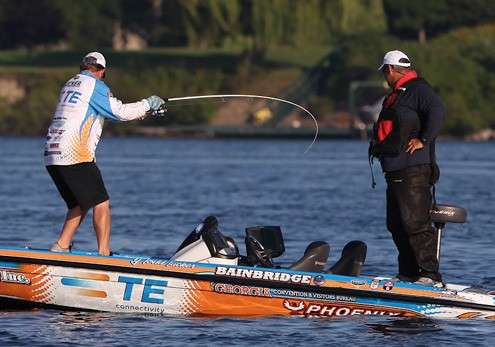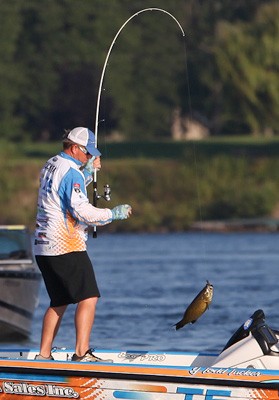
J Todd Tucker says swimbaits are fun baits for reasons other than that they catch big fish.
“You see a lot of fish that you won’t see by fishing other lures,” he said. “Even if they just follow the bait but won’t hit it, you gain confidence knowing they’re in the area.”
For example, Tucker likes to fish swimbaits around docks when trying to locate docks that hold fish.
“Curious, less aggressive bass that won’t hit the swimbait often will follow it out,” Tucker explained. “You can go back later with a drop shot or Senko and catch ’em.”
That doesn’t mean bass won’t crush swimbaits. They do. However, the lures must be selected and presented properly to draw bass’ interest. Here are Tucker’s keys to being a more effective swimbait angler:
Water clarity: Don’t bother tying on a swimbait unless the water you’re fishing relatively clear.
“If you can’t see three to four feet beneath the surface, don’t bother,” he said. “Remember, this is a lure for sight biters, and there isn’t a lot of vibration to help draw the bass to the bait.”
Make it track straight: Swimbaits don’t always run true right out of the package, so you need to test them in the water to make sure they look natural and aren’t rolling to the side. If that’s happening, bass will ignore them.
“You can make minor adjustments in how a bait runs by how you position the hook in the body,” he explained. “If it wants to run left, move the hook a little to the left to compensate for it.”
Weight can affect running depth, too. If the fish are holding in four feet and your bait runs six feet deep, you’re going to get fewer bites.
“It has to swim naturally and in the zone the fish are using,” the Georgia pro said. “You can’t just throw any bait and wind it in; the fish have to see it and everything has to look right to them.”
Color and size: Match the forage the bass are targeting and keep your bait the size of that forage. Also, big baits in small bass waters aren’t going to be as effective as smaller ones.
“Out West and in the South, the fish are bigger and accustomed to eating bigger forage,” Tucker offered. “But up North, the baitfish tend to be smaller.”

And different, too. Shad baits are popular in most waters, but if perch or bluegills are the primary forage (as in many northern waters), choose colors that match accordingly. Shad lookalikes might work, but more germane-colored baits will work better.
“Fish look at these baits and will study them while tracking them,” Tucker said. “You have to make it look as realistic as possible, in size, shape and swimming action.”
That doesn’t mean Tucker won’t customize his colors. Sometimes, a small detail can make a lot of difference, such as when Davy Hite won at Pickwick a couple of years ago by adding a bit of chartreuse to the tail of his swimbait.
“Don’t be afraid to experiment a little to make those followers bite,” Tucker noted.
Tucker likes to use translucent colors in clear water, but said there have been times when he’s had to darken them up to create a little contrast.
“I’ve had success taking a black marking pen and adding a black stripe down the back of the swimbait to knock down the translucent appearance,” he described. “Sometimes experimenting and tweaking can be a lot of work, but it can be fun and rewarding once you dial in the right combination and start catching fish others aren’t getting.”





